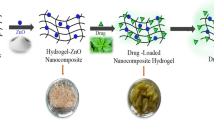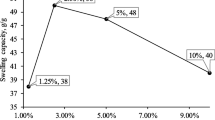Abstract
In the present studies, polysaccharide was extracted from 6 varieties of Cyamopsis tetragonoloba L. and its potential to form hydrogel was evaluated. The hydrogel formation was not observed in Desi and Neelam 51 variety but it formed particulate matter. Parasiya 954 and Maharani 92 formed intact, sticky, and watery gel whereas Swati and Nylon 55 formed intact, dense, and sticky gel with high water absorbing and swelling property. The rheological analysis of hydrogels (C, Pr2A, Mh2A, Sw2A, & Ny2A) suggested that they had a weak, flexible network structure and behaved as dilatant shear thickening fluid. The strength of Ny2A and Sw2A was high as compared to C, Pr2A, and Mh2A. The FESEM, FTIR, and XRD analysis of drug-loaded hydrogels confirmed the formation of polymerization in intact and sticky hydrogels, porous morphology, entrapment of insulin in hydrogels, the stable structure of insulin is retained and its amorphous dispersion in hydrogels, respectively. The in vitro controlled drug release was evaluated from each hydrogel by using insulin as a model drug using the Korsmeyer-Peppas model. The controlled drug (insulin) release was observed in formulations C, Pr2A, Mh2A, Sw2A, Ny2A, and Mh3A whereas controlled drug release was not observed in formulations Pr3A, Sw3A, Ny3A.












Similar content being viewed by others
Data availability
Data are included in the form of tables and figures.
References
Liyanage S, Abidi N, Auld D et al (2015) Chemical and physical characterization of galactomannan extracted from guar cultivars (Cyamopsis tetragonolobus L.). Ind Crops Prod 74:388–396
Srivastava M, Kapoor VP (2005) Seed galactomannans: an overview. Chem Biodivers 2(3):295–317
Prajapati VD, Jani GK, Moradiya NG et al (2013) Galactomannan: a versatile biodegradable seed polysaccharide. Int J Biol Macromol 60:83–92
Thakura S, Sharma B, Verma A et al (2018) Recent approaches in guar gum hydrogel synthesis for water purification. Int J Polym Anal Charact 23(7):621–632
Rithe SS, Kadam PG, Mhaske ST (2014) Preparation and analysis of novel hydrogels prepared from the blend of guar gum and chitosan: cross-linked with glutaraldehyde. Adv Mater Sci Eng 2:1–15
Elsaeed SM, Zaki EG, Omar WA et al (2021) Guar gum-based hydrogels as potent green polymers for enhanced oil recovery in high-salinity reservoirs. ACS Omega 6(36):23421–23431
Chen X, Martin BD, Neubauer TK et al (1995) Enzymatic and chemoenzymatic approaches to synthesis of sugar based polymer and hydrogels. Carbohydr Polym 28:15–21
Kashyap N, Kumar N, Kumar M (2005) Hydrogels for pharmaceutical and biomedical applications. Crit Rev Ther Drug Carr Syst 22:107–149
Hamidi M, Azadi A, Rafiei P (2008) Hydrogel nanoparticles in drug delivery. Adv Drug Deliv Rev 60(15):1638–1649
Singh A, Sharma PK, Garg VK et al (2010) Hydrogels: a review. Int J Pharm Sci Rev Res 4(2):97–105
Zhang L, Li K, Xiao W et al (2011) Preparation of collagen–chondroitin sulfate–hyaluronic acid hybrid hydrogel scaffolds and cell compatibility in vitro. Carbohydr Polym 84(1):118–125
Saul JM, Williams DF (2011) Hydrogels in regenerative medicine. Handbook of polymer applications in medicine and medical devices. William Andrew Publishing, pp 279–302
Hiremath JN, Vishalakshi B (2012) Effect of crosslinking on swelling behaviour of IPN hydrogels of guar gum & polyacrylamide. Der Pharma Chemica 4(3):946–955
Verma D, Sharma SK (2021) Recent advances in guar gum based drug delivery systems and their administrative routes. Int J Biol Macromol 181:653–671
Sullad AG, Manjeshwar LS, Aminabhavi TM (2010) Novel pH-sensitive hydrogels prepared from the blends of poly(vinyl alcohol) with acrylic acid-graft-guar gum matrixes for isoniazid delivery. Ind Eng Chem Res 49:7323–7329
Soppimath KS, Kulkarni AR, Aminabhavi TM (2000) Controlled release of antihypertensive drug from the interpenetrating network poly (vinyl alcohol)–guar gum hydrogel microspheres. J Biomater Sci Polym Ed 11(1):27–43
Palem RR, Shimoga G, Rao KSV et al (2020) Guar gum graft polymer-based silver nanocomposite hydrogels: synthesis, characterization and its biomedical applications. J Polym Res 27(3):1–20
Kumar B, Murali A, Bharath AB et al (2019) Guar gum modified upconversion nanocomposites for colorectal cancer treatment through enzyme-responsive drug release and NIR-triggered photodynamic therapy. Nanotechnology 30(31):315102
Chen LG, Liu ZL, Zhuo RX (2005) Synthesis and properties of degradable hydrogels of konjac glucomannan grafted acrylic acid for colon-specific drug delivery. Polymer 46(16):6274–6281
Bashir S, Teo YY, Ramesh S et al (2016) Synthesis, characterization, properties of N-succinyl chitosan-g-poly (methacrylic acid) hydrogels and in vitro release of theophylline. Polymer 92:36–49
Takehara H, Hadano Y, Kanda Y, Ichiki T (2020) Effect of the thermal history on the crystallinity of poly (L-lactic Acid) during the micromolding process. Micromachines 11(5):452
Paixão MVG, de Carvalho BR (2018) Application of guar gum in brine clarification and oily water treatment. Int J Biol Macromol 108:119–126
Shabir F, Erum A, Tulain UR et al (2017) Preparation and characterization of pH sensitive crosslinked Linseed polysaccharides-co-acrylic acid/methacrylic acid hydrogels for controlled delivery of ketoprofen. Des Monomers Polym 20(1):485–495
Gulrez SK, Al-Assaf S, Phillips GO (2011) Hydrogels: methods of preparation, characterisation and applications. In: Progress in molecular and environmental bioengineering-from analysis and modeling to technology applications, pp 117–150
Nagasawa N, Yagi T, Kume T et al (2004) Radiation crosslinking of carboxymethyl starch. Carbohydr Polym 58(2):109–113
Lin WJ, Lu CH (2002) Characterization and permeation of microporous poly (ε-caprolactone) films. J Membr Sci 198(1):109–118
Ranjha NM, Hanif M, Afzal Z et al (2015) Diffusion coefficient, porosity measurement, dynamic and equilibrium swelling studies of Acrylic acid/Polyvinyl alcohol (AA/PVA) hydrogels. Pak J Pharm Res 1(2):48–57
Kokol V, Pottathara YB, Mihelčič M et al (2021) Rheological properties of gelatine hydrogels affected by flow-and horizontally-induced cooling rates during 3D cryo-printing. Colloids Surf A Physicochem Eng Asp 616:126356
Abd El-Mohdy HL, Hegazy EA, El-Nesr EM et al (2016) Synthesis, characterization and properties of radiation-induced Starch/(EG-co-MAA) hydrogels. Arab J Chem 9:S1627–S1635
Shah N, Patel K (2014) Formulation and development of hydrogel for poly acrylamide-co-acrylic acid. J Pharm Sci Biosci Res Patel 4:114–120
Bradford MM (1976) A rapid and sensitive method for the quantitation of microgram quantities of protein utilizing the principle of protein-dye binding. Anal Biochem 72(1–2):248–254
Hammer Ø, Harper DA, Ryan PD (2001) PAST: paleontological statistics software package for education and data analysis. Palaeontol Electron 4(1):9
Mudgil D, Barak S, Khatkar BS (2012) X-ray diffraction, IR spectroscopy and thermal characterization of partially hydrolyzed guar gum. Int J Biol Macromol 50(4):1035–1039
Warrand J, Michaud P, Picton L et al (2005) Structural investigations of the neutral polysaccharide of Linum usitatissimum L. seeds mucilage. Int J Biol Macromol 35(3–4):121–125
Kačuráková M, Belton PS, Wilson RH et al (1998) Hydration properties of xylan-type structures: an FTIR study of xylooligosaccharides. J Sci Food Agric 77(1):38–44
Kačuráková M, Ebringerova A, Hirsch J et al (1994) Infrared study of arabinoxylans. J Sci Food Agric 66(3):423–427
Thombare N, Mishra S, Siddiqui MZ et al (2018) Design and development of guar gum based novel, superabsorbent and moisture retaining hydrogels for agricultural applications. Carbohydr Polym 185:169–178
Fringant C, Tvaroska I, Mazeau K et al (1995) Hydration of α-maltose and amylose: molecular modelling and thermodynamics study. Carbohydr Res 278(1):27–41
Mudgil D, Barak S, Khatkar BS (2012) Effect of enzymatic depolymerization on physicochemical and rheological properties of guar gum. Carbohyd Polym 90(1):224–228
Tayal A, Pai VB, Khan SA (1999) Rheology and microstructural changes during enzymatic degradation of a guar−borax hydrogel. Macromolecules 32(17):5567–5574
Jafry HR, Pasquali M, Barron AR (2011) Effect of functionalized nanomaterials on the rheology of borate cross-linked guar gum. Ind Eng Chem Res 50(6):3259–3264
Bishop M, Shahid N, Yang J et al (2004) Determination of the mode and efficacy of the cross-linking of guar by borate using MAS 11B NMR of borate cross-linked guar in combination with solution 11B NMR of model systems. Dalton Trans 17:2621–2634
Mesmer RE, Baes CF, Sweeton FH (1972) Acidity measurements at elevated temperatures: VI. Boric acid equilibriums. Inorg Chem 11:537–543
Wang S, Tang H, Guo J et al (2016) Effect of pH on the rheological properties of borate crosslinked hydroxypropyl guar gum hydrogel and hydroxypropyl guar gum. Carbohydr Polym 147:455–463
Harris PC (1993) Chemistry and rheology of borate-crosslinked fluids attemperatures to 300 F. J Pet Technol 45:264–269
Sharma K, Kumar V, Chaudhary B et al (2016) Application of biodegradable superabsorbent hydrogel composite based on Gum ghatti-co-poly (acrylic acid-aniline) for controlled drug delivery. Polym Degrad Stab 124:101–111
Amin MCIM, Ahmad N, Halib N et al (2012) Synthesis and characterization of thermo-and pH-responsive bacterial cellulose/acrylic acid hydrogels for drug delivery. Carbohydr Polym 88(2):465–473
Zhang J, Chu LY, Cheng CJ et al (2008) Graft-type poly (N-isopropylacrylamide-co-acrylic acid) microgels exhibiting rapid thermo-and pH-responsive properties. Polymer 49(10):2595–2603
Mahdavinia GR, Pourjavadi A, Hosseinzadeh H et al (2004) Modified chitosan 4. Superabsorbent hydrogels from poly (acrylic acid-co-acrylamide) grafted chitosan with salt-and pH-responsiveness properties. Eur Polym J 40(7):1399–1407
Ranjha NM, Qureshi UF (2014) Preparation and characterization of crosslinked acrylic acid/hydroxypropyl methyl cellulose hydrogels for drug delivery. Int J Pharm Pharm Sci 6(4):400–410
Pourjavadi A, Barzegar S, Mahdavinia GR (2006) MBA-crosslinked Na-Alg/CMC as a smart full-polysaccharide superabsorbent hydrogels. Carbohydr Polym 66(3):386–395
Ranjha NM, Ayub G, Naseem S et al (2010) Preparation and characterization of hybrid pH-sensitive hydrogels of chitosan-co-acrylic acid for controlled release of verapamil. J Mater Sci Mater Med 21(10):2805–2816
Soleimani F, Sadeghi M (2012) Synthesis of pH-sensitive hydrogel based on starch-polyacrylate superabsorbent. J Biomater Nanobiotechnol 3(2A):310–314
Highley CB, Rodell CB, Burdick JA (2015) Direct 3D printing of shear-thinning hydrogels into self-healing hydrogels. Adv Mater 27(34):5075–5079
Sittikijyothin W, Sampaio P, Goncalves MP (2007) Heat-induced gelation of-lactoglobulin at varying pH: effect of tara gum on the rheological andstructural properties of the gels. Food Hydrocoll 21:1046–1055
Ritger PL, Peppas NA (1987) A simple equation for description of solute release I. Fickian and non-fickian release from non-swellable devices in the form of slabs, spheres, cylinders or discs. JCR 5(1):23–36
Ritger PL, Peppas NA (1987) A simple equation for description of solute release II. Fickian and anomalous release from swellable devices. JCR 5(1):37–42
Acknowledgments
The authors wholeheartedly thank and appreciate the support given by the Department of Biosciences, Department of Chemistry SAIF facility, National Facility for Drug Discovery, Center of excellence, Saurashtra University, and CSIR-CSMCRI, Bhavnagar to carry out the present research work.
Funding
Authors are wholeheartedly thankful to State Government of Gujarat, India for Shodha Fellowship given to Ph.D student to carry out the present research work.
Author information
Authors and Affiliations
Contributions
SA performed experiments for this research work as a part of her Ph.D thesis. JGT contributed to experiment design, standardization of experiments, data analysis, interpretation of results, and manuscript preparation.
Corresponding author
Ethics declarations
Conflict of interest
Authors declare that there is no conflict of interest regarding publication of this research article in journal.
Consent for publication
Authors give consent for publication of this research work in your esteemed journal.
Ethical approval
No ethical approval is required for this present research work.
Consent to participate
Authors declare to participate for the publication of this research work in your esteemed journal
Additional information
Publisher's Note
Springer Nature remains neutral with regard to jurisdictional claims in published maps and institutional affiliations.
Supplementary Information
Below is the link to the electronic supplementary material.
Rights and permissions
Springer Nature or its licensor holds exclusive rights to this article under a publishing agreement with the author(s) or other rightsholder(s); author self-archiving of the accepted manuscript version of this article is solely governed by the terms of such publishing agreement and applicable law.
About this article
Cite this article
Alooparampil, S.J., Tank, J.G. Assessing the potential of galactomannan isolated from six varieties of Cyamopsis tetragonoloba L. for hydrogel formation and controlled drug delivery. Polym. Bull. 80, 8819–8844 (2023). https://doi.org/10.1007/s00289-022-04483-w
Received:
Revised:
Accepted:
Published:
Issue Date:
DOI: https://doi.org/10.1007/s00289-022-04483-w




